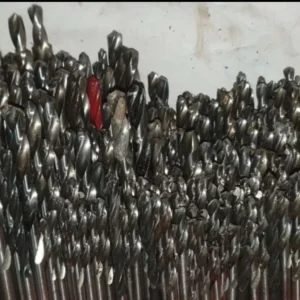Get High Speed Steel Scrap Price Per Kilogram is 200rs per kilogram
- The average price of High-Speed Steel Scrap is 200 Rs per kilogram throughout the year. It’s important to note that this price is subject to fluctuation based on factors such as quality, quantity, location, and other variables. For regular updates on the HSS scrap price and other scrap prices, it is recommended to follow the company’s YouTube and other social media channels to stay informed about the latest changes and trends in scrap prices.

Understanding High Speed Steel Scrap
High speed steel (HSS) is a type of tool steel renowned for its exceptional hardness, wear resistance, and ability to retain cutting edge at high temperatures. It is widely used in various industries, including manufacturing, aerospace, and automotive, for cutting, shaping, and forming metal components. However, like any other material, HSS undergoes wear and tear over time, leading to the generation of scrap.
What is High Speed Steel?
High speed steel, commonly abbreviated as HSS, is a type of alloy steel distinguished by its high resistance to abrasion and ability to maintain hardness even at elevated temperatures. It typically contains alloying elements such as tungsten, molybdenum, chromium, and vanadium, which enhance its mechanical properties. HSS is used in the production of cutting tools, drills, taps, and other equipment requiring high wear resistance and cutting performance.
The Importance of Recycling High Speed Steel Scrap
Recycling high speed steel scrap is crucial for several reasons. Firstly, it conserves natural resources by reducing the need for virgin materials in steel production. Secondly, it contributes to energy savings and reduces greenhouse gas emissions associated with primary steelmaking processes. Additionally, recycling HSS scrap helps alleviate the burden on landfills and promotes a circular economy where materials are reused and repurposed, minimizing waste and environmental impact.
Factors Influencing High Speed Steel Scrap Prices
The price of high speed steel scrap is influenced by various factors, both global and local, which collectively determine its market value.
Global Demand and Supply
The demand for high speed steel scrap is heavily influenced by global economic conditions, particularly in industries such as manufacturing, construction, and automotive. Fluctuations in demand for finished steel products directly impact the availability and pricing of HSS scrap. Similarly, changes in supply, driven by factors such as metalworking activity, industrial output, and infrastructure development, can affect scrap prices.
Economic Trends
Economic indicators, including GDP growth, inflation rates, and currency exchange rates, play a significant role in shaping high speed steel scrap prices. Strong economic growth typically leads to increased industrial activity and higher demand for steel products, driving up scrap prices. Conversely, economic downturns may result in reduced demand and lower scrap prices as industries cut back on production and consumption.
Quality and Quantity of HSS Scrap
The quality and quantity of high speed steel scrap also influence its pricing. Scrap with higher purity levels and minimal contamination commands higher prices due to its suitability for recycling into high-quality steel products. Additionally, the volume of available scrap supply relative to demand affects pricing dynamics, with shortages often leading to price spikes and surpluses resulting in downward pressure on prices.
Pricing Mechanisms in the High Speed Steel Scrap Market
The high speed steel scrap market operates under various pricing mechanisms designed to reflect prevailing market conditions and facilitate transactions between buyers and sellers.
Market Dynamics
High speed steel scrap prices are determined by market forces of supply and demand, with buyers and sellers negotiating prices based on prevailing market conditions. Factors such as scrap quality, quantity, delivery terms, and payment terms influence the bargaining process, leading to price discovery through competitive interactions between market participants.
Pricing Models
Several pricing models are used in the high speed steel scrap market, including spot pricing, index pricing, and negotiated pricing. Spot pricing involves immediate transactions at prevailing market prices, providing flexibility but subject to price volatility. Index pricing references published price indices or benchmarks to determine scrap prices, providing transparency and stability but may lag behind real-time market changes. Negotiated pricing allows buyers and sellers to agree on custom pricing based on specific terms and conditions, offering flexibility but requiring negotiation efforts.
Impact of Currency Fluctuations
Currency fluctuations can significantly impact high speed steel scrap prices, especially in the context of international trade. Changes in exchange rates between currencies affect the competitiveness of steel exports and imports, influencing demand for scrap and ultimately its pricing. Currency devaluations or appreciations can lead to price adjustments to offset changes in purchasing power and maintain market competitiveness.
Methods of Determining High Speed Steel Scrap Prices
Determining high speed steel scrap prices involves various methods and approaches tailored to meet the needs of market participants and address specific market conditions.
Spot Pricing
Spot pricing, also known as cash pricing, involves immediate transactions at prevailing market prices without long-term commitments. Buyers and sellers negotiate prices based on real-time market conditions, taking into account factors such as scrap quality, quantity, and delivery terms. Spot pricing provides flexibility and agility in responding to market changes but may expose parties to price volatility and uncertainty.
Index Pricing
Index pricing relies on published price indices or benchmarks to determine high speed steel scrap prices. These indices reflect aggregated market data and price movements over time, providing transparency and stability to pricing mechanisms. Market participants reference index prices as a basis for their transactions, aligning with established benchmarks to mitigate risks and ensure fair pricing. However, index pricing may lag behind real-time market changes and require periodic adjustments to reflect current market conditions accurately.
Negotiated Pricing
Negotiated pricing allows buyers and sellers to engage in direct negotiations to establish custom pricing based on specific terms and conditions. Parties negotiate prices based on factors such as scrap quality, quantity, delivery schedules, payment terms, and contractual obligations. Negotiated pricing offers flexibility and customization, enabling parties to address unique requirements and preferences. However, it requires time and effort to reach mutually acceptable agreements, and prices may vary depending on negotiation outcomes and market dynamics.
Trends in High Speed Steel Scrap Pricing
High speed steel scrap prices exhibit dynamic trends influenced by various factors, including market demand, supply conditions, economic trends, and industry dynamics.
Historical Price Analysis
Analyzing historical price data provides insights into long-term trends and patterns in high speed steel scrap pricing. Historical price analysis enables market participants to identify cyclical patterns, seasonal fluctuations, and price trends over time. Understanding historical price dynamics helps stakeholders make informed decisions regarding scrap procurement, inventory management, and pricing strategies.
Forecasting Future Prices
Forecasting future high speed steel scrap prices involves assessing market fundamentals, economic indicators, and industry trends to anticipate price movements. Market analysts use quantitative and qualitative methods, including statistical modeling, trend analysis, and expert judgment, to forecast prices with varying degrees of accuracy. Forecasting helps stakeholders anticipate market developments, mitigate risks, and optimize decision-making regarding scrap purchasing, pricing, and inventory management.
Influence of Industry Trends
Industry trends and developments play a significant role in shaping high speed steel scrap prices. Technological advancements, regulatory changes, and shifts in consumer preferences impact the demand for steel products and, consequently, the availability and pricing of scrap. Emerging trends such as lightweighting in automotive manufacturing, renewable energy infrastructure projects, and digitalization in industrial processes influence the demand for high speed steel scrap and drive market dynamics.
Strategies for Maximizing Returns on High Speed Steel Scrap
Maximizing returns on high speed steel scrap requires adopting strategic approaches that optimize scrap collection, processing, and marketing while minimizing costs and risks.
Efficient Sorting and Processing
Efficient sorting and processing of high speed steel scrap are essential to maximize its value and quality. Implementing advanced sorting technologies, such as magnetic separation, eddy current separation, and optical sorting, helps segregate HSS scrap from other materials, ensuring higher purity and yield. Utilizing state-of-the-art processing equipment, such as shredders, shears, and balers, enables efficient handling and preparation of scrap for recycling, enhancing productivity and profitability.
Building Relationships with Scrap Buyers
Building strong relationships with scrap buyers is critical to securing favorable pricing and market access for high speed steel scrap. Developing long-term partnerships with reputable buyers and suppliers fosters trust, transparency, and collaboration throughout the supply chain. Effective communication, reliable service, and consistent quality assurance help differentiate suppliers and enhance their competitiveness in the market. Collaborating with buyers to understand their specific needs and preferences enables suppliers to tailor their offerings and value-added services to meet customer requirements effectively.
Investing in Technology and Equipment
Investing in technology and equipment is essential for optimizing scrap recycling processes and improving operational efficiency. Upgrading to modern recycling equipment, such as advanced shredders, shears, and sorting systems, enhances productivity, throughput, and material recovery rates. Implementing digital solutions, such as inventory management software, data analytics tools, and automation systems, streamlines operations, reduces costs, and enhances decision-making capabilities. Investing in technology and equipment enables scrap recyclers to stay competitive, adapt to evolving market demands, and capitalize on emerging opportunities in the high speed steel scrap market.
Conclusion
In conclusion, high speed steel scrap prices are influenced by a multitude of factors, including global demand and supply, economic trends, scrap quality, and pricing mechanisms. Understanding these factors and adopting strategic approaches to maximize returns on scrap recycling is essential for stakeholders in the steel industry. By investing in technology, building strong relationships with buyers, and embracing sustainable practices, businesses can capitalize on opportunities in the high speed steel scrap market while minimizing environmental impact and promoting resource conservation.
FAQs About High Speed Steel Scrap Prices
What factors determine the price of high speed steel scrap?
The price of high speed steel scrap is influenced by factors such as global demand and supply, economic trends, scrap quality, and pricing mechanisms.
How can I track high speed steel scrap prices?
You can track high speed steel scrap prices through industry publications, commodity exchanges, scrap metal pricing websites, and direct communication with scrap buyers and sellers.
Are there any regional variations in high speed steel scrap prices?
Yes, high speed steel scrap prices may vary regionally due to factors such as local demand and supply dynamics, transportation costs, and regulatory differences.
Can I negotiate prices when selling high speed steel scrap?
Yes, you can negotiate prices when selling high speed steel scrap, particularly through negotiated pricing mechanisms that allow buyers and sellers to agree on custom pricing based on specific terms and conditions.
What are the environmental benefits of recycling high speed steel scrap?
Recycling high speed steel scrap conserves energy, reduces landfill waste, and preserves natural resources, contributing to environmental sustainability and mitigating climate change.
